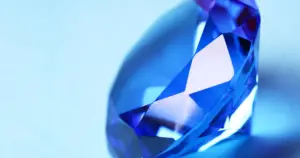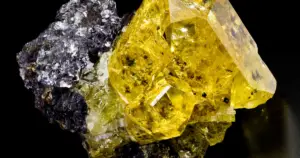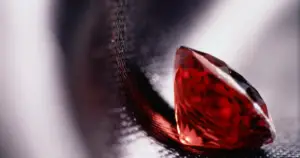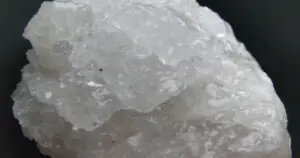Nephrite Jade Meaning: Healing Properties, Benefits and Uses
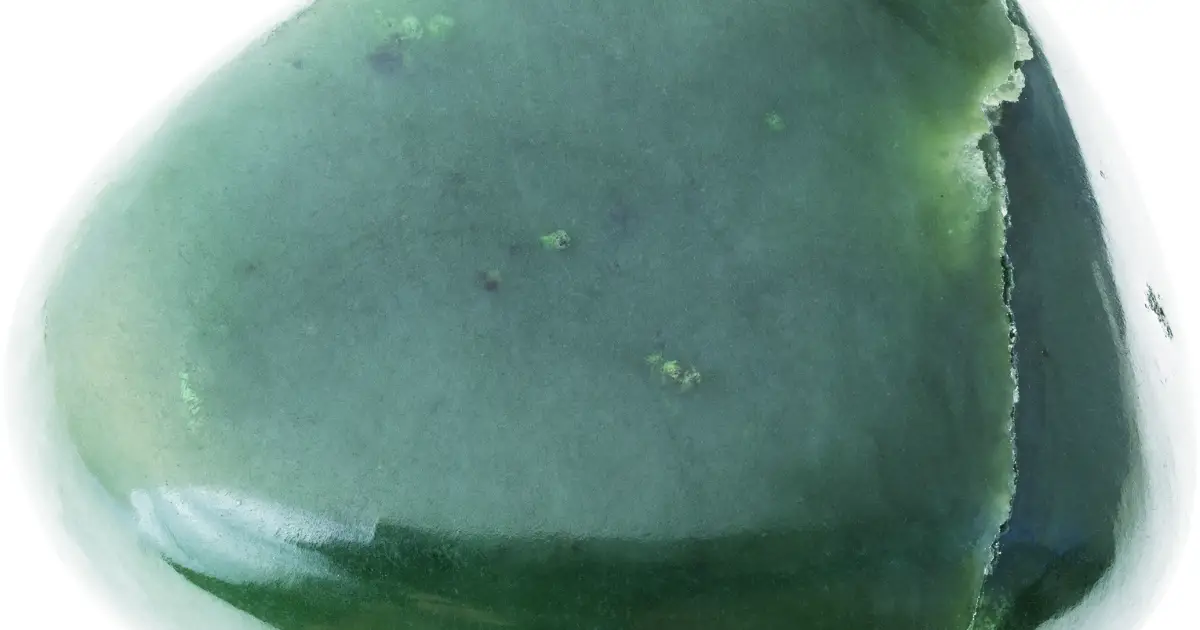
One of the three minerals that are often referred to as “jade” is nephrite, along with jadeite and omphacite. Nephrite is a fibrous variant of the actinolite-tremolite series mineralogically. The cabochon above, which weighs 4.95 ct, originates from Lake Baikal in Russia.
Jadeite is a pyroxene mineral, whereas nephrite is a fibrous aggregate variety of tremolite-actinolite, a basic calcium-magnesium-iron silicate. Nephrite is more common than jadeite, and although it is slightly softer, its denser structure makes it tougher. Because there are no jadeite deposits in China, traditional Chinese jade is usually nephrite. Green nephrite is the most valuable nephrite today, but translucent, white nephrite was the most valuable until the introduction of fine Burmese ‘imperial’ jadeite jade in the 18th century. Many people also get confused with White Jade, read here to know all about White Jade.
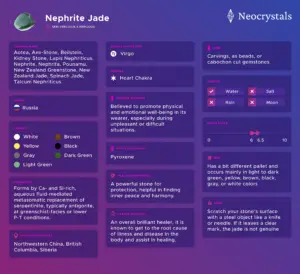
Table of Contents
What is Nephrite Jade?
Nephrite jade stones have dense and fibrous crystal masses and stunning crystal minerals. In traditional Chinese culture, it is regarded as a highly valuable and sacred substance. Despite their very different chemical compositions, nephrite jade and jadeite have been confused since their discovery.
Nephrite jade is a soft, fibrous stone. It is the type of jade most commonly associated with carvings, jewelry, and home decor in Western society. Nephrite is unquestionably the more popular and widely used of the two types, as well as easier to find. If you are interested to know all the benefits that the family of Jade stone as a whole possesses, click here.
How to Identify a Nephrite Jade?
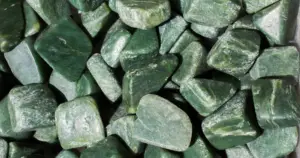
Most experts believe that identifying the different types of jade is simple. The lower level of luster and translucency of nephrite distinguishes it from jadeite. The luster of nephrite is slightly greasy to resinous. Nephrite is softer than jadeite and has a lower density (despite being more compact in structure, nephrite’s specific gravity ranges from 2.90 to 3.03, while jadeite’s ranges from 3.30 to 3.38). Other green gemstones, such as aventurine or serpentine, are frequently mistaken for nephrite jade, but serpentine is much softer and aventurine’s texture and color are not as smooth. Emerald and chrysoprase are much harder than nephrite and have different colors than jade.
Nephrite Jade Cuts
- Jadeite is slightly softer than nephrite (between 6-6.5 Mohs hardness).
- Nephrite is commonly found in creamy white (also known as “mutton fat” Jade in China), mid- to deep olive green, brown, and black.
- Also known as New Zealand Greenstone.
- The majority of modern nephrite jade comes from Canada.
Nephrite Jade Shapes
Typically, nephrite is cut into cabochons, beads, or other simple shapes. Because its luster is not as strong as that of jadeite, it is difficult to find it in faceted stones. Because this jade is popular for carving, you’ll see a lot of nephrite ornaments and sculptures with intricate details.
Where is Nephrite Jade Found?
Nephrite is found in low-grade, metamorphosed rocks. Throughout history, the region of Khotan (Ho-t’ien) and Yarkand in Central Asia has been China’s most important source of nephrite. Other significant sources include the Lake Baikal region of Siberia, the South Island of New Zealand, the Kotzebue area of Alaska, the Sweetwater River in Wyoming, and the canton of Graubünden in Switzerland. Large nephrite boulders have been discovered near Jordanów (Jordansmühl) in Silesia, Poland, as well as in the valleys of the Turnagain and Fraser rivers in British Columbia. The first occurrence of nephrite on the African continent was discovered in 1960 at Mashaba, Rhodesia. The mineral was discovered in 1965 near Hualien, Taiwan (Formosa).
Nephrite Jade Stone Meaning
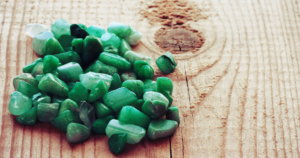
The name Nephrite is derived from the Greek word “nephros,” which literally means “kidney.” The boulders, rocks, and pebbles from which nephrite jade is mined resemble the shape of a kidney. When the Chinese discovered nephrite jade many years ago, they were inspired by the kidney shape of the rocks to believe that this beautiful stone would aid in the healing of kidney disease.
Nephrite jade is a silicate crystal that comes in a variety of colors, making it difficult to tell the difference between nephrite jade and jadeite. Nephrite jade stones are most commonly found in green or beige hues. They can also be found in dark brown, black, grey-brown, yellow, and yellow-green colors.
The most common locations for nephrite jade stones are Russia, New Zealand, China, Thailand, and Canada. It is also found in the following countries, but in much lower abundance: Australia, Mexico, Taiwan, Brazil, Poland, Zimbabwe, Italy, Switzerland, and Germany.
Nephrite Jade Meaning in Ancient Lore and History
The very first of these materials discovered in China was nephrite jade, which has been used and carved since ancient times. Nephrite was so valuable that traditional deposits in China are nearly depleted. There is evidence that jadeite jade, primarily from Burma, began to be traded on a larger scale in China in the 14th century. It was harder, denser, and easier to work with, and it eventually became the gemstone preferred by Chinese artisans and prized by the Chinese people.
However, the traditional nephrite jade of the country is not forgotten. At the 2008 Beijing Olympics, each athlete’s medal was embedded with a piece of pure, natural-carved jade. The gold medal displayed a rare type of white nephrite known as “mutton fat” jade.
Nephrite Jade Crystal Properties
There are the following properties:
- Ca2(Mg, Fe2+)5[OHlSi4O11] is the chemical formula. 2; Calcium magnesium aluminum silicate, basic
- Monoclinic crystal structure with intergrown fine fibrous aggregates
- Colors include light to dark green, black, yellow to brown, pink, white, and others.
- Mohs scale hardness: 6 to 6.5
- 1.600 to 1.627 Refractive Index
- 2.90 to 3.03 density
- There is no cleavage.
- Transparency ranges from translucent to opaque.
- -0.027 for double refraction or birefringence; often none.
- Dull, vitreous, and greasy luster
- There is no fluorescence.
Nephrite Jade Healing Properties

Overall, nephrite jade is a fantastic healer. It is known to help heal the body by getting to the root cause of illness and disease. It is a revitalizing stone that is said to hasten the healing process of the body. Nephrite jade protects the body from harmful external influences and calms the nervous system. It can also strengthen and heal the immune system while bringing your body into a more alkaline state.
Nephrite jade is said to be one of the best stones for women suffering from PMS symptoms and infertility. Daily use of nephrite jade is said to balance and heal anything related to the female reproductive center. It is a thoughtful gift for pregnant women, especially if the birth is imminent, as the new mother can use the stones in her birth ceremony to invoke harmony, ease, and comfort. This wonderful stone is beneficial to the liver, kidneys, and heart. It cleanses the blood and aids in the regulation of blood supply and circulation issues.
Nephrite Jade Metaphysical Properties
Look into the face of a great carved Buddha to get a sense of the spiritual value of jade. Deep peace, balance, and strength can be found in that face. Nephrite jade is thought to promote those qualities in its wearers, providing physical and emotional well-being, particularly in unpleasant or difficult situations.
Nephrite is one of several durable stones known as “pounamu” by Maori, and it is highly valued as a taonga by them (treasure). Pounamu, which can be shaped into both tools and ornaments, gains prestige and social value as it is passed down through generations, and of course, as the kidney stone, nephrite is thought to cure kidney stones.
Nephrite Jade Benefits
Because of its support for love, devotion, and fidelity, nephrite jade is considered a dream stone. It also improves physical, mental, emotional, and spiritual health. The nephrite jade’s inherent energies are transferred and absorbed by the body. It can also help to cleanse negative energies, thereby awakening creative energies and passions.
Yoni Eggs contain a common form of nephrite. Yoni Eggs are intended to be used internally inside the vagina as a weight that creates resistance and activates the pelvic floor muscles. The exercises increase the flow of blood, which helps stimulate the nerves and improves sexual sensation by awakening dormant energies. The Yoni Egg is a fun way to do kegel exercises while also increasing your sexual energies and exuding calm confidence. It’s pleasure beyond your wildest dreams!
According to legend, the use of Yoni Eggs dates back to ancient China and is based on Taoist Tantra, which gives the wearer vitality, youth, and sexual prowess. Yoni is a Sanskrit word that means “sacred space.”
Other noteworthy advantages of using the yoni egg include reduced menstrual cramps, reduced symptoms of urinary incontinence, revitalization of the reproductive system, and healing of any trauma associated with sexual abuse.
Nephrite Jade Benefits Spirituality
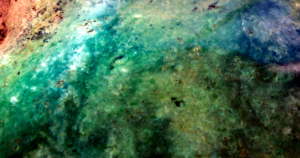
Nephrite Jade is a lovely stone with a lot of spiritual significance. It is the most valuable type of jade and is believed to have spiritual properties. Nephrite Jade may be the right stone for you if you’re looking for a stone that can help you find balance and peace.
Nephrite Jade is said to aid in the attainment of inner peace and harmony. It is said to guard against accidents and injuries, as well as negative energy and curses. Nephrite Jade is also said to aid in the attraction of love and money. It is thought to be a stone of abundance and is said to aid in fertility
Nephrite Jade & Feng Shui
In feng shui, or the practice of bringing balance to your life and home with energy, jade is a highly valued stone that represents gentleness, serenity, harmony, and balance. Jade has many meanings, including strength, good fortune, and health.
Jade is also valued for its healing properties, which help to balance the body’s processes. Jade is revered in China as a symbol of beauty and nobility. Buying it for yourself is not bad luck, especially if it brings you joy or makes you happy.
Nephrite Jade Birthstone
Nephrite Jade is a birthstone for those born in September. September babies are said to be hardworking, dependable, and determined. They are also known to be analytical and intellectual.
Nephrite Jade can assist those born in September in developing their natural work ethic and determination. It can also help them to be more dependable and to think things through before acting. Furthermore, Nephrite Jade can help them become more intellectual and analytical, which are traits that are beneficial to those born under this sign.
Nephrite Jade Chakras
The chakras associated with Nephrite Jade are said to be the heart chakra and the solar plexus chakra. The heart chakra represents love and compassion, whereas the solar plexus chakra represents personal power and inner strength.
What are the Uses of Nephrite Jade?
The uses of Nephrite Jade are:
- Jewelry:
Nephrite jade is frequently used in jewelry designs due to its beautiful coloring. Rings, beaded bracelets, tumbled pendants, raw stones, anklets, earrings, and necklaces are all examples of nephrite jewelry.
Beaded Nephrite jewelry is the most popular style, but there are also intricate carvings. Other gemstones, such as pearls, are used in some designs. Nephrite is frequently set against sterling silver metal or earthy designs incorporating leather rope.
- Decor:
Carvings in nephrite jade are a popular style of decor, trinkets, and religious talismans. Jade carvings have adorned Chinese culture and heritage for thousands of years. The character “Yu” in Chinese directly translates to the English word “Jade.”
The medals for the 2008 Beijing Olympics were mounted with Nephrite Jade, which is embedded in Chinese history and culture.
Because this material is so important to Chinese culture, it is frequently used in home decor. Intricate nephrite carvings depict life, history, culture, and religion in China, including Buddha, horses, and fish.
- Healing:
We briefly discussed Nephrite jade’s healing properties, but now let’s look at how you can use it. If you need assistance manifesting your dreams, you can use the healing stone to reduce negative energy. This will make room for inspirational and uplifting energy to enter your life. When you feel good, you’ll be more motivated to pursue your goals.
Furthermore, Nephrite jade promotes calm by quieting the mind and all the noise of life. You’ll gain clarity, confidence, and sensory abilities in this quiet space, allowing you to tap into a deeper level of self-awareness.
- Artwork:
For centuries, the nephrite gemstone has been used to create beautiful artwork. It was thought to have healing properties by the Chinese. As a result, they carved small statues from this stone to place in their homes or gardens as a place of meditation.
Jade can be carved into a variety of shapes and forms, such as animals, people, or abstract designs.
Caring for Nephrite Jade
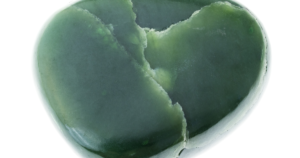
Nephrite jade is a tough stone, but it is not indestructible. To clean nephrite jewelry, use a soft cloth and lukewarm soapy water. Because nephrite is porous and absorbs colors readily, it is important to rinse thoroughly. (For the same reason, avoid chemicals, ultrasonic cleaners, and steamers.)
Keep nephrite away from extreme temperature changes, prolonged heat, and bright light. Keep nephrite separate from other gemstones to avoid scratches and fractures in both the nephrite and the other stones. Always wrap your gemstones in soft cloth, use a fabric storage bag, or store them in a fabric-lined jewelry box.
When to Cleanse Nephrite Jade
To keep its energy, Nephrite Jade should be cleansed on a regular basis. One of the most effective ways to cleanse it is to expose it to the light of the sun or moon for an extended period of time. You can also use a method like smudging or crystal cleansing water.
How to Recharge Your Nephrite Jade
Other stones, such as amethyst and clear quartz, are best for charging and cleansing nephrite jade. The other stones absorb and transmute any negative energy stored in your nephrite jade.
Nephrite Jade Activation process
Nephrite jade is a very popular stone for all types of jewelry. Wearing the stone as much as possible is the best way to benefit from its powerful healing support.
Another way to use this stone’s power is to use it in your morning meditation. It’s the ideal stone to use to set intentions for the day because of its ability to help you manifest your dreams into reality.
How much is Nephrite Jade worth?
The cost of nephrite jade varies according to its quality and size. In general, Nephrite Jade is inexpensive, with prices ranging from $10 to $200 per stone. Mutton fat jade is the rarest nephrite, so it’s no surprise that it’s the most valuable of this jade type. A pound of mutton fat could cost $68,000 or more.
Siberian jade is another rare and valuable nephrite. In 2015, the highest quality of this variation was priced at $22,727. A slightly lower quality variation costs around $900. If you want to know if Jade stone is expensive, click here.
What determines Nephrite Jade’s price and value?
Because nephrite is more readily available, it is less expensive than jadeite. However, depending on the quality, color, and location of origin, the stone is still valuable.
Nephrite Jade Impact
- Color, origin, and size are the most important value factors for jade gemstones.
- The most valuable jade color is called “imperial jade,” and it only occurs in jadeite. Imperial jade is green with blue and yellow undertones. The ideal tone is medium-dark, with around 75% saturation of green hues.
Jadeite and nephrite are both graded according to their treatments:
- Type A: Natural, untreated jade. There may be a wax coating, but nothing else.
- Type B: Jade that has been bleached and polymerized.
- Type C: Jade contains dye.
- Type B+C: Jade has been bleached, polymerized, and dyed.
Does Nephrite Jade make a Good Jewelry stone?
Although less hard than jadeite, nephrite’s dense, and fibrous structure makes it more difficult to carve. With hardnesses ranging from 6 to 6.5, nephrites are susceptible to scratching, so protective jewelry settings are recommended, particularly for ring use. Both nephrite and jadeite, on the other hand, make excellent jewelry stones.
Nephrite Jade Real vs Fake
- Check for irregularities:
Fibrous, granular, or felt-like marks will intertwine within the structure of genuine nephrite and jadeite. Holding the jade stone up to a bright light will reveal these marks. A 10x loupe makes it even easier to see them.
The most commonly used compound to imitate jade is chrysoprase, which is microcrystalline. Because of its microcrystalline structure, chrysoprase will not have these marks.
Look for layers as you examine the stone with a 10x loupe. Layering indicates that the jade has been doubled. Doubling is the process by which a manufacturer applies a thin layer of genuine jade over a different base.
Genuine jade or nephrite should only have felt-like marks; any layers and a homogeneous appearance indicate fake jade.
You might be wondering if the marks can be replicated, but it is difficult. Even if the seller succeeds, the other characteristics that distinguish genuine jade from imitation jade will expose their deception.
- Check for flaws:
In most cases, flaws in gemstones are regarded as a disadvantage. When it comes to jade, however, flaws add value. As previously stated, vein-like fibers indicate that the jade is genuine.
Bubbles are a flaw that you do not want to see. Once again, a loupe is used to detect these.
Some sellers may be offended if you examine their jewelry too closely. Be wary if the retailer is overly insistent on you inspecting their jade. It’s possible they’re trying to conceal something.
- Density check:
Jadeite and nephrite are both relatively dense minerals. The density of jadeite is approximately 3.0, while the density of nephrite is approximately 3.3.
The first method for determining density is to toss the stone into the air and catch it. The stone should feel heavier than similar-sized stones.
The second method will necessitate the possession of a genuine piece of jade. Tap the genuine jade against the tested jade. If the other piece of jade sounds like two plastic beads tapping against each other, it is most likely fake.
It would be preferable if you could accurately measure the mass and volume using the appropriate tools. This is not possible when you are in a retailer’s store.
- The scratch test:
Jadeite is a tough stone that can scratch glass and most metals. There should be no scratches on the surface of pure jadeite if any of these substances are used to scratch it. There might be a white line, but it should be simple to remove.
Because nephrite is not as hard as jadeite, you may end up damaging the stone you’re testing.
When carrying out this test, exercise extreme caution. Even if a stone turns out to be fake jade, it may still be valuable. You could, for example, end up damaging green quartz or prehnite.
If you decide to use the scratch test, only use it on a piece that you already own. Make sure to conduct the scratch test on an area of the stone that is not easily visible.
- Check the temperature:
Genuine jade should feel cold and soapy to the touch when held. It should take some time for a genuine piece of jade to warm in your palm.
Because it is subjective, this test is not completely accurate. What one person considers cold may be considered warm by another.
One way to improve the accuracy of this test is to compare it to genuine jade of similar shape and size. It’s best to do this simultaneously, with one piece in each hand.
- Testing the sound:
The sound test, like the others, works best if you have a real piece of jade with you. Compare the jade you’re testing to genuine jade. A clinking, bell-like sound should be heard. This is because it is denser than most gemstones of comparable size.
Tapping real jade on the glass should produce a heavier, bell-like chime. Many other gems have a hollow sound. If the jade stone you’re testing makes these sounds, it’s most likely fake.
FAQs
Is Nephrite Jade real Jade?
Nephrite is real jade. Before the discovery of jadeite in 1863, it was the only type of jade available. Even though this is not the most valuable type of jade, it is still a valuable gemstone.
Why is Nephrite Jade so expensive?
Despite the fact that jadeite is the more valuable type of jade, nephrite is still expensive in comparison to many other gemstones. The mutton fat and Siberian jade varieties of Nephrite are the most expensive.
What is the difference between Jade and Nephrite Jade?
Because nephrite is a type of jade, there is no inherent distinction between jade and nephrite jade. However, it differs from jadeite in some ways. The mineral composition, available colors, texture, and transparency level of nephrite differ from those of jadeite.
What is Nephrite Jade worth?
The average price of common nephrite per pound ranges between $100 and $1,000. Jewelry pieces range in price from $30 to $100 and up. Mutton fat jade is the rarest nephrite, so it’s no surprise that it’s the most valuable of this jade type. A pound of mutton fat could cost $68,000 or more.
How do I know if my Jade is Nephrite?
Nephrite jade is less translucent and shiny than jadeite. Its resin-like clarity and slightly rough texture set it apart from other types of jadeite.
